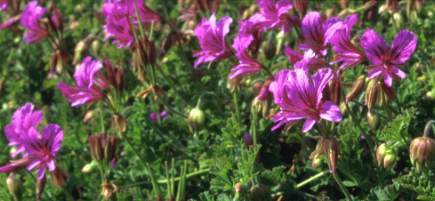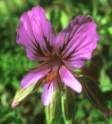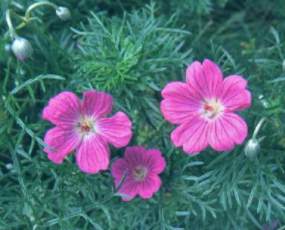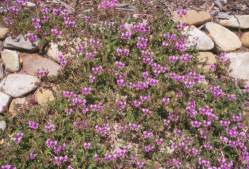Pelargonium suburbanum subsp. suburbanum
Pelargonium suburbanum Clifford ex Boucher subsp. suburbanum
Family: Geraniaceae
Common names: dune pelargonium (Eng.) wildemalva
Introduction
A groundcover with showy magenta flowers in spring and early summer, ideal for sandy banks, rockeries and hanging baskets. Many species and hybrids of Pelargonium are commonly called geraniums, a misnomer that has stuck.

Description
Description
Pelargonium suburbanum subsp. suburbanum is a sprawling, mat forming herbaceous shrublet to 300 mm, with dark green leaves and large dark pink to purple flowers from mid-winter to mid summer (June to well into January).
Conservation Status
Status
Pelargonium suburbanum subsp. suburbanum is assessed as Vulerable (VU) on the Red List of South African Plants. This species has lost more than 30% of its habitat and fewer than 10 locations remain. Urban development, agriculture and invasive alien plants are destroying its natural habitat.
Distribution and habitat
Distribution description
Pelargonium suburbanum occurs in the winter rainfall area of southern Africa, from the Cape Peninsula to Port Elizabeth. This particular subspecies occurs in coastal areas in the Eastern Cape from Humansdorp to Port Elizabeth, where it often grows in openings in low scrub on sand dunes. This area receives rain in summer too.
Derivation of name and historical aspects
History
Pelargonium suburbanum subsp. suburbanum belongs in the family Geraniaceae, a large cosmopolitan family of approximately 11 genera and 800 species in subtropical and temperate regions of the world. The South African genera in the Geraniaceae family are Pelargonium, Geranium, Erodium, Monsonia and Sarcocaulon. There are approximately 270 species of Pelargonium which occur in S, E and NE Africa, Asia, St Helena, Tristan da Cunha, Madagascar, Australia and New Zealand, most of which ( ± 219 species) occur in southern Africa, with a large concentration of more than 135 species that occur in the southern portion of South Africa between Nieuwoudtville in the West and Port Elizabeth in the East.
The distinctive shape of the seed pod of geranium plants is responsible for the name of the both the genus Geranium and the family Geraniaceae, from the Greek geranos, a crane, as the seed pod resembles the head and beak of a crane. Similarly Pelargonium is derived from the Greek pelargos, a stork, and Erodium is from the Greek erodios, a heron, as the fruit resembles the head and/or bill of these birds. The botanical names can thus be translated as crane's-bill, stork's-bill and heron's-bill respectively. The name suburbanum refers to the original name given to this plant, Pelargonium urbanum, as the first collection of this plant was apparently made in an urban area (urbanus in Latin). The common name, wildemalva, means 'wild mallow' in English, and is a name applied to many South African pelargoniums, although not in the translated form.

Many species and hybrids of Pelargonium are commonly called geraniums, while true geraniums are also commonly called geraniums, or are known as crane's-bill. This 'name-sharing' has resulted in confusion between these two genera, but they can in fact be very easily distinguished.

The genus Geranium has flowers with five equal petals symmetrically arranged that can be divided into two equal halves along more than one plane, while the genus Pelargonium has flowers which can only be cut into two equal halves along one plane, in this case the vertical plane. The flowers of Pelargonium suburbanum subsp. suburbanum for instance have two large upper petals and two or three much smaller lower petals. A photograph of Geranium incanum, the carpet geranium, is shown above for comparison between a typical Geranium flower and a Pelargonium flower.
Plants from both genera are grown in large numbers in gardens in both the Northern and Southern Hemisphere. Pelargoniums are one of the most popular pot- and bedding plants in Europe and North America and have been cultivated since 1672, when they were first introduced to the European public. Francis Masson collected about fifty species of Cape pelargoniums in 1772. From these and other South African species, plant breeders have produced the ivy-leaved-, zonal-, regal-, rose- and other types of "geraniums" with flowers in colours from dazzling white to deep, nearly black purple. However, many of the pure species from South Africa, although more difficult to cultivate than the commercial varieties, are just as varied and amazing in form and colour.
Uses
Use
Although no medicinal or cultural uses are recorded for this species, many of the South African Pelargonium species have strongly scented foliage and some hybrids produce oils that are used in the perfume industry.
Growing Pelargonium suburbanum subsp. suburbanum
Grow

Pelargonium suburbanum subsp. suburbanum is a fast growing, showy, long flowering plant, an outstanding plant for rockeries, walls and steep slopes, an excellent ground cover in a sunny position in any garden, and is tolerant of coastal conditions. It is also suitable for hanging baskets, window boxes or tubs. It flowers from mid-winter until mid-summer (the end of June to well into January), with a peak during early summer (October to December).
Pelargoniums like plenty of light, a well-drained soil, and good air circulation. Light shade or full shade for part of the day is tolerated by most South African Pelargonium species. In their natural environment they are found growing in the shelter of bushes or rocks, where even if the leaves are exposed, the roots are cool. A good sandy, loamy soil of 1 part loam : 2 parts sand : 2 parts compost, plus some fertilizer, will suit most pelargoniums. The soil pH is not a critical factor, and a neutral to slightly acidic pH is suitable for most species. Watering is an important factor in the cultivation of pelargoniums, both for their growth rate and for the health of the plants. A general rule of thumb is to only water when dry and under-watering is preferable to over-watering as almost all their problems in cultivation arise from over-watering or poor drainage. The stems of Pelargonium suburbanum subsp. suburbanum can be slightly hairy and thus retain water on their surface. Watering should be done in the early morning to prevent outbreaks of fungal diseases or rust. Pelargoniums are tender to frost and will succumb to wet cold and prolonged frost and are not suitable for permanent outdoor cultivation in areas with a winter minimum of less than -1 to 4 oC (30 to 40 oF) (USDA Zone 10).
The plants are not long lived and should be replanted after two years, when they tend to start dying off from the centre. However, they are very easy to propagate from cuttings and seed germinates readily.
Stem cuttings may be taken in summer or autumn from a parent plant that is strong and healthy. The stem should be fairly firm but not woody, with at least 3 to 5 leaf nodes, and cut just below a node. The leaves and stipules should be removed leaving only a few leaves intact on the top. Large leaves may be trimmed to reduce moisture loss. The cuttings should be left to dry for a few hours before being placed in the soil. The cuttings should be rooted in trays or in cold frames, in a well-drained medium e.g. coarse river sand. They can also be planted directly into the ground, as long as they are given light shade and are watered regularly until they have rooted. The basal ends of the cutting should be dipped in a rooting hormone to improve the rate of rooting and inserted in a prepared hole made by a dibber or a nail to avoid damaging the ends. The cuttings should be watered regularly but kept on the dry side, as over-watering will result in losses. After root formation has started, 4 to 8 weeks later, the cuttings should be fed with a seaweed-based fertilizer and potted up 1 or 2 weeks after this. Plants produced this way will flower in approximately 3 to 6 months.
The seed of pelargoniums has an interesting mechanism: the elliptical seeds have a feathered tail-like structure, which is coiled into a spiral. The tail causes the seed to be twisted around so that it drills into the soil in a corkscrew fashion and thus secures itself in the soil. For optimum germination, seed is best sown when fresh, although it may remain viable for up to 7 years. Sow seed in a light, well-drained soil with a high content of coarse sand. Firm down and level the medium gently. Broadcast the seed evenly, covering it with a layer of clean sand. The depth of sowing is usually one and a half times the size of the seed. Water thoroughly but gently and provide light shade. Germination usually takes place within 10 to 14 days but can take longer if temperatures are low. Plants grown from seed are generally more vigorous than those produced from cuttings, however, they take longer to flower, from 12 to 18 months after sowing, and may also display a certain amount of variation.
References
- Van der Walt, J.J.A. & Vorster, P.J., 1988, Pelargoniums of Southern Africa, Volume 3, National Botanic Gardens, Cape Town
- Powrie, F. (compiled by), Grow South African Plants, Kirstenbosch Gardening Series, National Botanical Institute, Cape Town
- Lighton, Conrad., 1973, Cape Floral Kingdom
- Bailey, L.H., The Standard Cyclopedia of Horticulture
- Jackson, W.P.U., 1990, Origins and Meanings of Names of South African Plant Genera, U.C.T. Printing Dept., Cape Town.
- Leistner, O.A. (ed.), 2000, Seed plants of southern Africa: families and genera, Strelitzia 10., National Botanical Institute, Pretoria
Credits
H.G. Jamieson and L. May
Kirstenbosch National Botanical Garden
August 2001
conservation information updated in August 2016
Plant Attributes:
Plant Type: Ground Cover, Perennial
SA Distribution: Eastern Cape
Soil type: Sandy, Loam
Flowering season: Spring, Early Summer, Winter
PH: Acid, Alkaline, Neutral
Flower colour: Purple, Pink
Aspect: Full Sun, Morning Sun (Semi Shade), Afternoon Sun (Semi Shade)
Gardening skill: Easy
Special Features:
Horticultural zones











Rate this article
Article well written and informative
Rate this plant
Is this an interesting plant?
Login to add your Comment
Back to topNot registered yet? Click here to register.